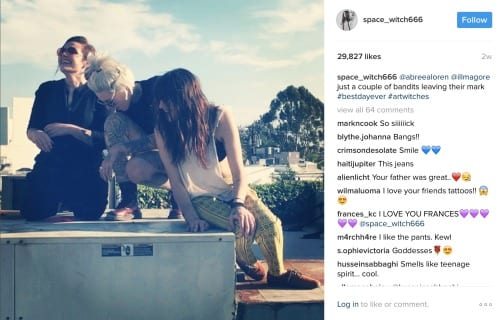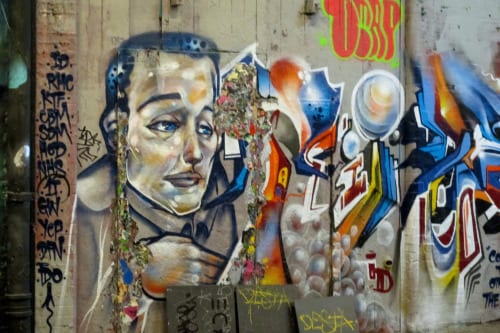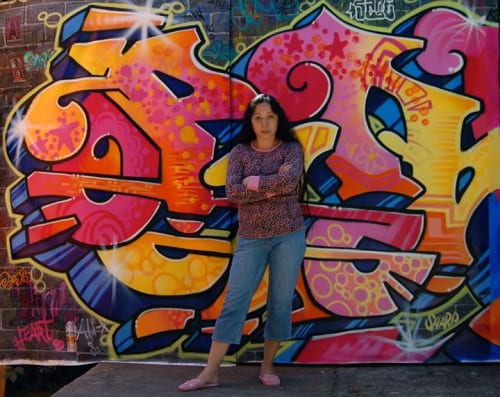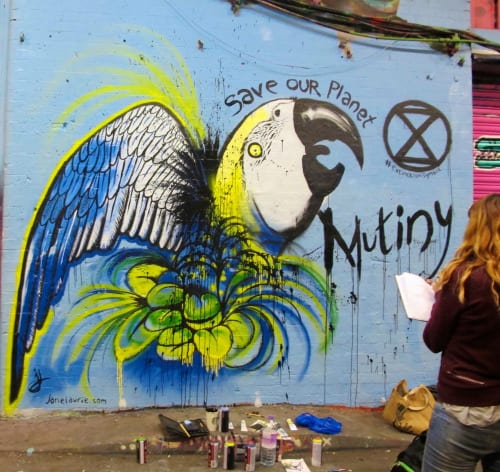Frances Bean Cobain and the Graffiti of Privilege
by Alison Stine | April 10, 2017 11:31 am
A friend saw it, driving in Los Angeles. A billboard for tony fashion line Marc Jacobs, featuring Frances Bean Cobain as the model, had been defaced with graffiti.
And then the news: Cobain had done it herself. There are pictures of Cobain and giggling friends in action with rollers and paint, and a video of the defacing, posted by none other than Marc Jacobs, which suggests, if the graffiti wasn’t sanctioned, it was at least fine.
Nobody’s getting arrested. Nobody seems to be mad.

As a graffiti fan and a visual artist, I should love this. Right? In a way, I do. It’s mixed media, incorporating large paste-ups, including one of a Marc Chagall-esque face which was plastered over Cobain’s image, and dripping painted letters that read: Witch, witch, she’s a witch. It’s well-designed and should be: Cobain’s collaborators were “creative consultant” Abreea Loren and artist Illma Gore.
But in another way, in a deeper way, I view Cobain’s defacing of her billboard as a gigantic waste.
For most artists, the stakes are high in graffiti. You could be arrested, fined. Mugged or assaulted if you’re out at night, sexually harassed or worse. I’ve had artist friends cut by thrown bottles, attacked by passing drunks. You risk a lot to make art on the street. Why make it bland? Why make it for no reason?
My gut response to the billboard: So?
Art shouldn’t make you shrug. It should make you shudder. It should make you push your face against the window, as I did the first time I saw Keith Haring’s Crack Is Wack, I was looking so hard. It should make you weep, as I did the first time I saw the Shoreditch walls in London, with graffiti on every corner: colorful and strange. It should matter.

Cobain’s graffiti isn’t saying anything. It doesn’t have a message, other than I can. It’s just fun—but it’s fun that wealthy white people are most able to get away with. After its defacement, the message of the Marc Jacobs billboard remained the same: It was still an advertisement for privilege.
Of course it’s not surprising that the most popular graffiti artists of today are white men: Shepard Fairey, Banksy. They got rich on graffiti. Like so much of non-white cultures, graffiti has been co-opted, commoditized—and banalized.
But the contemporary graffiti movement owes its life to young people of color, poor kids of the 1970s and 80s, who popularized the art in New York and Philadelphia. In its history and at its core, graffiti is the voice of the voiceless, the oppressed and forgotten. Young graffiti writers and artists of color such as Lady Pink started covering subway cars and billboards with paint to prove they existed, that they were here, that, despite what the culture at large was saying, they mattered—a motive that just doesn’t work for Cobain: We know you exist, you’re famous.

Artists lost their freedom to make graffiti. They lost –and still lose—their lives. One of the teenage graffiti artists in the 1983 documentary Style Wars, about hip-hop culture of the late 1970s and early 1980s, had lost his arm in a subway accident—and still he painted.
I don’t think Cobain will continue in graffiti—but I wish that she would. I wish she would use the platform she was born with to give others a lift: paint endangered animals like Mutiny, or paste-ups of people experiencing homelessness like Blek Le Rat, or even anti-consumerism slogans like Banksy. I wish she would trade on her relative safety to stand up.

Maybe next time—if there is a next time—she could say something.
This article first appeared on Paint is Power.
